Fruit formation
How is a fruit formed?
• One of the organs that remains on the plant after pollination and fertilization is the ovary
• Within the ovary, the developing embryo produces special chemical substances that stimulate the young ovary
• These substances also signal the start of the formation of the fruit, which is a mature ovary
• The fruit may contain one or more seeds
• During fruit formation the ovary increases in size while ripening or maturing
• A true fruit is formed from the ovary of a flower after fertilization
• It has two scars(style scar and stalk scar) and contains seeds
• Some seeds are not formed from the ovary of a flower
• Some other parts of a flower develop to form a fruit
• Such fruits are called false fruits
How are fruits grouped?
Simple fruits
• formed from a single flower or one ovary e.g. mango
Aggregate fruits
• consists a group of ovaries that appear on a common receptacle e.g. strawberry
Multiple (compound) fruits
• formed from several flowers whose ovaries fuse together after fertilization
• form a bunch e.g. pineapple, figs
• are always false fruits
What are succulent fruits?
• also called fleshy fruits
• all or part of pericarp (fruit wall) becomes juicy
Types of juicy fruits
-Berry
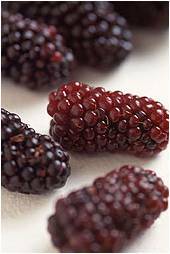
• has many seeds
• whole pericarp is succulent e.g. orange, tomato, pawpaw
Drupe
• only one seed
• pericarp divided into three layers i.e. epicarp, mesocarp(juicy) and endocarp(hard)
• e.g. mango and coconut
Pome
• juicy part is swollen receptacle
• is usually a false fruit
• example is a pear
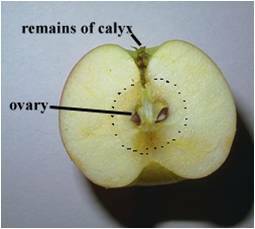
What are dry fruits?
• have a pericarp that is dry, hard and woody
• either dehiscent or indehiscent
• called dry because they are not succulent
What are dehiscent fruits?
• split open when ripe to release seeds
• contain many seeds
Give types of dehiscent fruits
Legumes
• split along two edges
• are usually pods e.g. beans, peas, crotolaria
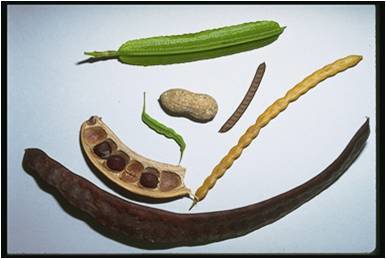
Follicle
• split on one side only e.g. Sodom apple
Capsule
• has several lines of weakness/sutures
• open in many places e.g. castor oil, cotton
What are indehiscent fruits?
• non-splitting fruits
• usually one seeded only
Give main types of indehiscent fruits
Nut
• pericarp woody, hard and thick e.g. cashew
Achene
• has thin, tough pericarp e.g. sunflower
Placentation
• arrangement of ovules within the plant ovary
Types of placentation
Marginal
• placenta appears as one ridge on ovary wall
• ovules are attached to placenta in rows e.g. peas in a pod
Basal
• placenta formed at the base of the ovary with numerous ovules attached to it.
Parietal
• edges of carpels fuse together
• dividing walls disappear, leaving one loculus
• have numerous seeds e.g. passion fruit
• placenta of each carpel appears as ridges on ovary wall
Axile
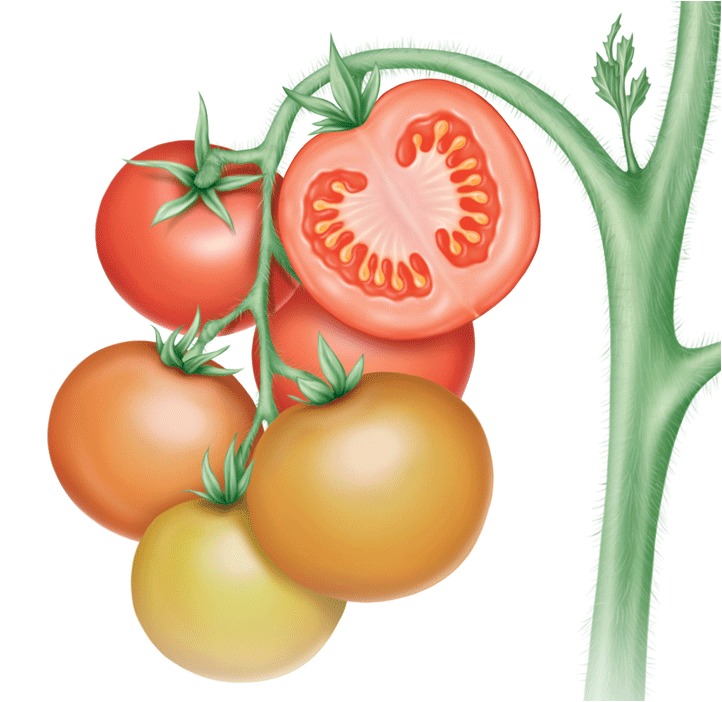
• edges of carpels fuse together to form a single central placenta
• numerous ovules arranged on placenta
• ovary divided into a number of loculi by walls of the carpel e.g.
Free central placentation
• edges of carpels fuse together
• dividing was disappears leaving one loculus
• placenta appears at base of ovary
• has numerous ovules
Importance of fruits in the survival of plants
• Protect the seed against dessication, predators and adverse conditions
• Aid in seed dispersal by attracting agents of dispersal
• Stores food for the plant
Differences between parthenogenesis and parthenocarpy
• Parthenogenesis is development of new animals from unfertilized eggs
• Parthenocarpy is development of a fruit without fertilization
How is a seed formed?
• After fertilization, zygote grows into an embryo, primary endosperm nucleus developed into endosperm, interguments harden to form testa, hence the whole ovule becomes the seed
• the seed loses water to become drier
• the seed has plumule, radicle, seed leaves called cotyledons, a microphyle and a scar
iii) A diagram of a seed
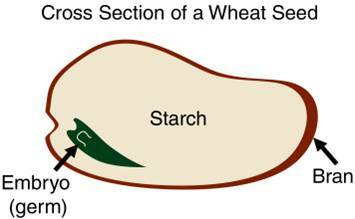
The main parts of a seed
Testa
• also called seed coat
• a tough outer covering which protects the seed from insects, bacteria etc
• segment is the membrane inside the testa
Hilum
• a scar
• spot where the seed was attached to the fruit or pod
Micropyle
• small hole through which water and air enter the seed
Radicle
• embryonic root
• grows into the shoot system
Cotyledons
• embryonic leaves
• store food for the germinating seed i.e. for plumule and radicle
• when plumule and radicle grow, they use food stored in the cotyledon
• in some seeds food is stored in the endosperm
The differences between a seed and fruit
• One of the organs that remains on the plant after pollination and fertilization is the ovary
• Within the ovary, the developing embryo produces special chemical substances that stimulate the young ovary
• These substances also signal the start of the formation of the fruit, which is a mature ovary
• The fruit may contain one or more seeds
• During fruit formation the ovary increases in size while ripening or maturing
• A true fruit is formed from the ovary of a flower after fertilization
• It has two scars(style scar and stalk scar) and contains seeds
• Some seeds are not formed from the ovary of a flower
• Some other parts of a flower develop to form a fruit
• Such fruits are called false fruits
How are fruits grouped?
Simple fruits
• formed from a single flower or one ovary e.g. mango
Aggregate fruits
• consists a group of ovaries that appear on a common receptacle e.g. strawberry
Multiple (compound) fruits
• formed from several flowers whose ovaries fuse together after fertilization
• form a bunch e.g. pineapple, figs
• are always false fruits
What are succulent fruits?
• also called fleshy fruits
• all or part of pericarp (fruit wall) becomes juicy
Types of juicy fruits
-Berry

• has many seeds
• whole pericarp is succulent e.g. orange, tomato, pawpaw
Drupe
• only one seed
• pericarp divided into three layers i.e. epicarp, mesocarp(juicy) and endocarp(hard)
• e.g. mango and coconut
Pome
• juicy part is swollen receptacle
• is usually a false fruit
• example is a pear

What are dry fruits?
• have a pericarp that is dry, hard and woody
• either dehiscent or indehiscent
• called dry because they are not succulent
What are dehiscent fruits?
• split open when ripe to release seeds
• contain many seeds
Give types of dehiscent fruits
Legumes
• split along two edges
• are usually pods e.g. beans, peas, crotolaria

Follicle
• split on one side only e.g. Sodom apple
Capsule
• has several lines of weakness/sutures
• open in many places e.g. castor oil, cotton
What are indehiscent fruits?
• non-splitting fruits
• usually one seeded only
Give main types of indehiscent fruits
Nut
• pericarp woody, hard and thick e.g. cashew
Achene
• has thin, tough pericarp e.g. sunflower
Placentation
• arrangement of ovules within the plant ovary
Types of placentation
Marginal
• placenta appears as one ridge on ovary wall
• ovules are attached to placenta in rows e.g. peas in a pod
Basal
• placenta formed at the base of the ovary with numerous ovules attached to it.
Parietal
• edges of carpels fuse together
• dividing walls disappear, leaving one loculus
• have numerous seeds e.g. passion fruit
• placenta of each carpel appears as ridges on ovary wall
Axile

• edges of carpels fuse together to form a single central placenta
• numerous ovules arranged on placenta
• ovary divided into a number of loculi by walls of the carpel e.g.
Free central placentation
• edges of carpels fuse together
• dividing was disappears leaving one loculus
• placenta appears at base of ovary
• has numerous ovules
Importance of fruits in the survival of plants
• Protect the seed against dessication, predators and adverse conditions
• Aid in seed dispersal by attracting agents of dispersal
• Stores food for the plant
Differences between parthenogenesis and parthenocarpy
• Parthenogenesis is development of new animals from unfertilized eggs
• Parthenocarpy is development of a fruit without fertilization
How is a seed formed?
• After fertilization, zygote grows into an embryo, primary endosperm nucleus developed into endosperm, interguments harden to form testa, hence the whole ovule becomes the seed
• the seed loses water to become drier
• the seed has plumule, radicle, seed leaves called cotyledons, a microphyle and a scar
iii) A diagram of a seed

The main parts of a seed
Testa
• also called seed coat
• a tough outer covering which protects the seed from insects, bacteria etc
• segment is the membrane inside the testa
Hilum
• a scar
• spot where the seed was attached to the fruit or pod
Micropyle
• small hole through which water and air enter the seed
Radicle
• embryonic root
• grows into the shoot system
Cotyledons
• embryonic leaves
• store food for the germinating seed i.e. for plumule and radicle
• when plumule and radicle grow, they use food stored in the cotyledon
• in some seeds food is stored in the endosperm
The differences between a seed and fruit
| Seed | Fruit |
| • fertilized ovule | • fertilized ovary |
| • attached to placenta through funicle | • attached to branch through a stalk |
| • one scar called hilum | • two scars (style scar and stalk scar) |
| • has seed coat/testa | • has fruit wall/pericarp |
| • seed wall undifferentiated | • fruit wall is differentiated |